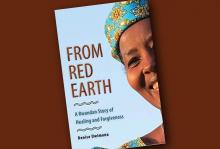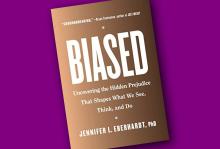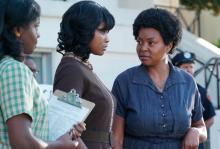Arts & Culture

It’s rare for large-scale action movies to attempt to meaningfully show the aftermath of destruction; the human realities of both one individual family, and entire nations are conveyed in those opening minutes. It feels … truthful? Alas, after that, Avengers: Endgame spends almost three hours pivoting between giving the truth and avoiding it.

Many white Americans want racial reconciliation to be like Borges’s legend. Like my relative’s friend, they want race and racism to be “over.” They think that Black and indigenous populations should forget that we stole their land and their bodies, made ourselves rich off their goods and their labor. After all, most white people have forgotten these facts. Slavery and manifest destiny are in the past, they protest; the civil rights movement has guaranteed equality for all — it even led to a black president. Instead of listening and entering into dialogue — the true beginning of reconciliation — they square up in the kitchen and declare racism “an excuse.”

A white blossom, purpled
at the edges like penance,
lies under an unbloomed tree.

“WORKING SHOULDER to shoulder, after sharing our struggles and tears, is forging a powerful bond,” said the woman laboring at my side. “Death once swept our land, but life has its own momentum.” When the fieldwork was done, we built a stable for Theresie, who had shared her hut with a cow. The young people helped, hauling poles and erecting the walls and roof.

IN HIS ESSAY “The Land Ethic,” environmentalist Aldo Leopold tells a story from The Odyssey in which Odysseus, upon returning to Troy, hangs a dozen slave girls for misbehaving in his absence. The act, Leopold writes, was not one of ethics but of property: “The ethical structure of that day ... had not yet been extended to human chattels.” Leopold uses this as an example of how our ethical structure has expanded over history. This expansion of the moral circle is a common thread in history, encompassing, slowly, people and things that were once outside moral consideration.

Biased is for every person who claims to not see color. As someone who navigates that phrase regularly in my professional anti-racism work, I was thrilled to read a book that swiftly debunks that statement—with data to back it.
Jennifer Eberhardt thoroughly outlines how racial bias is unavoidable in a society that historically institutionalized white supremacy, and she incorporates case studies, personal experiences, surveys, scientific research, and numerical data to prove it. She walks us through examples of various settings and institutions where this bias presents itself: policing, incarceration, socioeconomic status, schooling, housing, employment, customer service, personal interactions. All confirming that racial bias is, in fact, everywhere.

WHEN I STARTED writing this column a decade ago, the Oscars were about to address The Dark Knight not being nominated for Best Picture by expanding from five to 10 possible nominees. Only two Marvel Universe movies had been released, iPads didn’t exist, movies were still mostly shot on film, and #MeToo wasn’t known outside activist circles.
Today, as I write my final regular column for the magazine, the expanded nominations system has delivered one of the least plausible Best Picture awards in memory (Green Book), 22 Marvel movies have been released, people make films on iPads, watching cinema on a phone is second nature, and a new era of respect and accountability is dawning in the entertainment industry and elsewhere.

Inextinguishable Spirit
“Black faith still can’t be washed away” Solange sings in her album When I Get Home. The ambient work pays homage to her Houston roots while exploring themes of blackness and spirituality. Synth, syncopated drums, smooth vocals, and experimental time signatures form a liberating fusion of sound. Saint Records/Columbia

TO UNDERSTAND THE TRUMP PHENOMENON, which is at least in large part about race, I decided to read. Instead of reading more white people wrestling with what has gone wrong with white people, I, a white man, focused on African-American sources, mainly novels.
This move was first suggested to me by womanist ethicist Katie Cannon, who read the novelist Zora Neale Hurston as a primary source. I, too, began with Hurston, and then couldn’t stop. For two years, I have been reading classic novels by African-American authors, seeking an answer to these questions: How do black characters experience white people? How do they describe white Christian people’s morality and religion? The answers are clear—and devastating.

You don’t have to be in prison to recognize the power dynamics among the characters and how their bored desperation could remind us of what happens when the most emotionally unhealthy habits of mind mingle with the least human technologies. You don’t have to launch into space to find yourself clicking a button over and over and over, the offer of immediate gratification without genuine connection. It’s no wonder that the most psychologically mature astro-prisoner (played by André Benjamin) takes to sleeping in the garden — it’s the closest thing to real.

JUST WEEKS before the fire, I was in front of Notre Dame Cathedral in Paris, walking around the exterior and enjoying the architecture and ornate sculptures depicting stories of the Christian faith. I didn’t go inside, and I may never have the chance because of how long it will take to rebuild Notre Dame. The iconic wooden spire and roof are gone, as experts try to assess how to support the remaining structure and make it safe. There is international support and money to rebuild, because it appears a tragic accident has destroyed a place that is considered sacred even to those who consider themselves secular.
And that is why so many of us should keep going back to why the burning of three black churches in Louisiana didn’t fill 24-hour news cycles or make us—me—stop and turn on the news.

WITH THE COMING of spring and warm weather, my thoughts turned, as they always do, to the importance of the game of baseball in my family and the valuable lessons I’ve taken from it. We have a sign outside our home: “We interrupt this family for baseball season.” It reflects how much baseball means to our whole family and how much time and space it takes up in our day-to-day lives for much of the year.
Some of my most rewarding years as a father were the 11 years (and 22 seasons) that I coached my sons, Luke and Jack, in Little League Baseball. Though that time is past, baseball still very much connects our family as my sons have moved through school, with my oldest continuing to play baseball at Haverford College.

In the newest cinematic Mary Magdalene, directed by Garth Davis from a script by Helen Edmundson and Philippa Goslett, Mary isn’t confused at all. I don’t think anyone was expecting a film with that title to appear unironically in 2019; it's also a genuine surprise that it wasn’t made for the Christian market, nor does it aim for the kind of dry, “noble” distance that makes large-scale biblical epics such as Ben-Hur seem like Downton Abbey, upstairs, with sandals. The fact that Mary Magdalene contains decent performances (especially Rooney Mara’s Mary, not a doe-eyed holy innocent, but a leader who finds her voice by speaking), and makes an honest effort at exploring the less familiar parts of one of the most familiar stories in history makes it worth our attention. That attention may even be rewarded by an idea or two. It’s thoughtful, honest, yet not earth-shattering cinema, although it does bring its own revelation.

As Shamika and I called upon our own experiences in church and seminary, we became especially concerned with providing a resource for those who historically have been barred from participation at the Lord’s Table: the divorced, Christians of color, LGBTQ believers, those living far from physical community, or far from a church that is physically accessible. While we’re not trying to replace “brick and mortar” community, we believe God calls us beyond a spirit of fear in the face of innovations in technology.

The themes associated with “Gangster rap” and its successor, “Trap music,” are often thought of as being as far away from Christian morals as the east is from west. Heavy on percussion and profanity, its tracks hit hard and depict the violence of black life interspersed with tales of excess, sex, and money. While some may discount hip-hop music as vulgar entertainment, it indicates a people’s great hunger for getting more out of this world.

From Friday the 13th to Halloween, there’s nothing I love more than a great horror film that has a good twist at the end. Though they tend to follow the same predictable plot, I still enjoy the ride. Yet, there has never been a horror film that has stayed with me — until I watched Us directed by Jordan Peele. I sat in my car for 20 minutes thinking of how uneasy I felt, which I believe was the point of the film: to leave you unsettled. After watched it, I realized that Peele has not only created a haunting piece of art but has also proven to be a craftsman in the art of subversion. This film makes you question who you perceive to be the other and how that conflict manifests in our world.

SOMETHING WONDERFUL is happening in popular cinema: a new psychological depth married to kinetic technique that seems to emerge from filmmakers’ willingness to show their vulnerability. Notice how First Man is far more than a moon landing epic; it’s massively about the heart. Blindspotting takes racism more seriously than it takes itself. And Leave No Trace doesn’t settle for catharsis but invites us to do something in response to the brokenness on screen. There are dozens more films like this.
The psychological depth and open vulnerability of these films are mirrored in the way we talk about movies. It’s easy to find good film criticism that tells us about the writer’s life, and conversation about how cinema interacts with the world is no longer exclusively an elitist game.
But our favorite films don’t just tell us what we think about the world: They tell us something about what we think of ourselves. If what we pay attention to shows us what we love, it may also show us what we allow to love us. It bears exploration: What do our favorite films say about who we are, who we want to be, how we see the world, and what we feel we deserve? What are they inviting us to become?

THE AGE OF THE ROBOTS is here. If you didn’t notice, it’s because we’re calling them artificial intelligence (AI) and they don’t look like we expected. They’re the touchscreen kiosk that has replaced the cashier at Panera, the mechanical arms and claws flipping burgers at fast food joints, the drone that may someday deliver your Amazon order. They’re the software that can turn a baseball box score or corporate earnings report into a wire service news story.
According to a recent report from the Brookings Institute, about 38 percent of the adult population could be put out of work by smart machines in the next generation. The choices we are making about our AI future depend upon our answer to the question Wendell Berry posed 30 years ago with his book What Are People For? Up to now, at least in the U.S., the answer has been that people exist to generate corporate profits.
Andrew Yang, a Silicon Valley entrepreneur running for the Democratic presidential nomination, argues that Donald Trump is president because automation eliminated 4 million manufacturing jobs in the Rust Belt states Trump narrowly won. Yang expects that blue collar alienation will multiply soon, when driverless vehicles replace 3.5 million truck drivers.

Unity After Division
In the film The Best of Enemies, Oscar-nominated actress Taraji P. Henson portrays Christian civil rights activist Ann Atwater. Atwater and a Ku Klux Klan member are from opposite walks of life, but a school desegregation decree surprisingly places them on the same team. STX Entertainment
Healing Narratives
More than 20 years after its original printing, artist and activist Aurora Levins Morales’ book Medicine Stories: Essays for Radicals is republished with 12 new essays and updates to nine others. Levins Morales shares stories from her social justice-minded life to empower her peers and younger generations. Duke University Press

PAULA VOGEL WON the 1998 Pulitzer Prize for drama for “How I Learned to Drive” and is a veteran playwright of the American stage. But it wasn’t until 2017 that she finally made her way to Broadway with another of her prize-winning plays: the Tony Award-nominated “Indecent.”
“I wrote it as a love letter to the theater in 2015,” said Vogel, “and I never knew then how the play would resonate as strongly as it does today in these Trumped-up political times.”
“Indecent” tells the story of the theater troupe that performed Sholem Asch’s ill-fated Yiddish play “The God of Vengeance.” Premiering in 1922, “Vengeance” was the first play on Broadway to depict a lesbian love scene, causing a wave of notoriety everywhere it was performed. Asch’s play originated in Poland and tells the story of a Jewish brothel owner’s daughter who falls in love with one of his prostitutes. The father, on discovering his daughter’s forbidden love, throws the Torah down on the stage and banishes his daughter to a life of prostitution.
Asch’s leading actor in Poland warned him not to produce the play, but the play went on a whirlwind tour of success across Europe, finally arriving to New York City’s Greenwich Village in 1922. Despite this, when the show opened on Broadway, it was severely censored. “Why did you agree to those cuts?” the stage manager, Lemml, asks Asch in “Indecent.” “You cut the love between those two girls. There’s only sex left!”